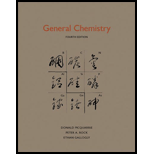
Concept explainers
Interpretation:
Whether carbon atoms can be held between iron atoms in its unit cell has to be determined.
Concept Introduction:
A unit cell is smallest repeating unit of a crystal lattice. Unit cells are classified as primitive and non-primitive. Unit cells that have atoms at only corners are primitive and unit cells that have atoms at positions other than corners are non-primitive.
Unit cells that are non- primitive are of various types:
Face centered unit cell (fcc), body centered unit cell (bcc), edge centered unit cell, end centered unit cell.
Contribution of an atom at a position is as follows:
Explanation of Solution
The formula to calculate the density of
Here,
Rearrange equation (3), to determine of
Substitute 2for
The formula to relate radius of iron atom and length of unit cell is as follows:
Substitute
The formula to determine volume of sphere is as follows:
Substitute
So the volume of 2 iron atoms present in unit cell is determined as follows:
Substitute
The formula to determine volume of cube is as follows:
Substitute
The vacant space present in the cube is calculated as follows:
The vacant space is large so carbon atom can be held between iron atoms in its unit cell.
Want to see more full solutions like this?
Chapter 15 Solutions
General Chemistry
 ChemistryChemistryISBN:9781305957404Author:Steven S. Zumdahl, Susan A. Zumdahl, Donald J. DeCostePublisher:Cengage Learning
ChemistryChemistryISBN:9781305957404Author:Steven S. Zumdahl, Susan A. Zumdahl, Donald J. DeCostePublisher:Cengage Learning ChemistryChemistryISBN:9781259911156Author:Raymond Chang Dr., Jason Overby ProfessorPublisher:McGraw-Hill Education
ChemistryChemistryISBN:9781259911156Author:Raymond Chang Dr., Jason Overby ProfessorPublisher:McGraw-Hill Education Principles of Instrumental AnalysisChemistryISBN:9781305577213Author:Douglas A. Skoog, F. James Holler, Stanley R. CrouchPublisher:Cengage Learning
Principles of Instrumental AnalysisChemistryISBN:9781305577213Author:Douglas A. Skoog, F. James Holler, Stanley R. CrouchPublisher:Cengage Learning Organic ChemistryChemistryISBN:9780078021558Author:Janice Gorzynski Smith Dr.Publisher:McGraw-Hill Education
Organic ChemistryChemistryISBN:9780078021558Author:Janice Gorzynski Smith Dr.Publisher:McGraw-Hill Education Chemistry: Principles and ReactionsChemistryISBN:9781305079373Author:William L. Masterton, Cecile N. HurleyPublisher:Cengage Learning
Chemistry: Principles and ReactionsChemistryISBN:9781305079373Author:William L. Masterton, Cecile N. HurleyPublisher:Cengage Learning Elementary Principles of Chemical Processes, Bind...ChemistryISBN:9781118431221Author:Richard M. Felder, Ronald W. Rousseau, Lisa G. BullardPublisher:WILEY
Elementary Principles of Chemical Processes, Bind...ChemistryISBN:9781118431221Author:Richard M. Felder, Ronald W. Rousseau, Lisa G. BullardPublisher:WILEY





